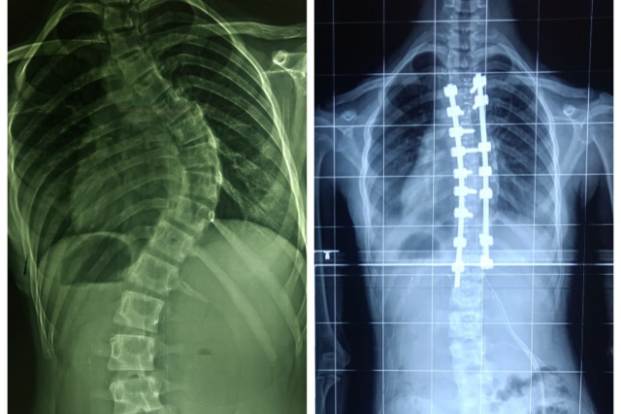
Mar 2, 2024
Successful operation of Spinal Cord Displacement in Paras Hospital Patna

Doctors at Paras HMRI Hospital Patna were able to successfully treat a 13 yr old patient suffering from congenital spinal deformities. The complex surgery and treatment was performed and managed by Dr Gautam Prasad, Consultant Spine Surgery, Department of Orthopedics.The teenage girl had onset of deformity since last 6 months. There was asymmetry of shoulders as well as of trunk- on front as well as back side. She was tilting on left side while walking and standing. The condition is called scoliosis and in absence of any underlying cause, this is called adolescent idiopathic scoliosis. Dr Gautam Prasad and his team was able to successfully diagnose the underlying issue with the help of the latest radiology diagnostic tool and recommend a suitable treatment plan.
Dr Guatam shares, “Since she was in growing stage, her situation was likely to worsen in the next 3 to 4 years. We counseled the parents regarding her deformity and suggested a surgery to avoid further deformity. Post surgery we were able to provide complete correction of her deformity and the patient was able to walk within 48 hours post surgery.
He further explains, “Deformity of the spine develops during the growing stage. At time it occurs due to malformation of vertebrae when the child is in the womb of the mother. These kinds of curves are seen immediately after birth and are noticed within the first 2 to 3 years of age. This is called as congenital scoliosis. Those which appear later but before 10 to 11 years of age are called infantile curves and ones which appear around puberty are called adolescent scoliosis.”

Regarding the causes of scoliosis, Dr Gautam also highlighted that mostly we don’t have any definite answer for the cause of curves and hence it is called as idiopathic scoliosis. These curves progress whenever the child grows. Hence the maximum change in quantum or degree of curve is seen when the child is at puberty. After 2 to 3 years of puberty the rate of increase in curvature slows down significantly.
These curves are associated with asymmetry of shoulders, chest- rib cage. Less frequently it is associated with tilting of the head or the entire body on one side leading to significant cosmetic issues. At times scoliosis is associated with other syndromes. Very rarely scoliosis is the cause of pain in the back or legs. There is also some misconception that the scoliosis can lead to paralysis. However Dr Gautam explained that unless scoliosis, which is the bony change in curvature of Spine, is accompanied with some defect in spinal cord, there is no additional risk of any weakness due to scoliosis.
Dr Gautam also shares that in majority of the cases surgery is the best way to treat spinal deformities. Treatment with brace is usually not effective in scoliosis presenting with large curve or having rapid progression. Such children need surgery. There are various types of surgeries – to arrest the growth of curvature (Scoliosis) and to correct it. This helps in improvement of physical appearance and self confidence and self esteem of the patient. The type of surgery and timing of surgery differs depending on magnitude of curve, age of presentation, the type of curve, growth rate during puberty, the rate of progression of curve, other coexisting medical conditions etc. This decision is taken by expert spine surgeons department of Orthopedics in consultation with parents of the child.
There is also a myth that these kinds of surgery are associated with high risks of paralysis. Dr Gautam explains that there has been tremendous advancement in technique and instrumentation. Today we have navigation system and fluoroscopy which helps in precise placement of screws to correct scoliosis. Neuro-monitoring systems further add to safety factor. This neuro- monitoring systems check the various signals starting from the brain and going to the legs, and vice versa. So if there is some untoward handling of spinal cord while placing screws or while correcting the scoliosis deformity, these systems alert the operating surgeons. Also there has been tremendous advancement in anesthesia.
